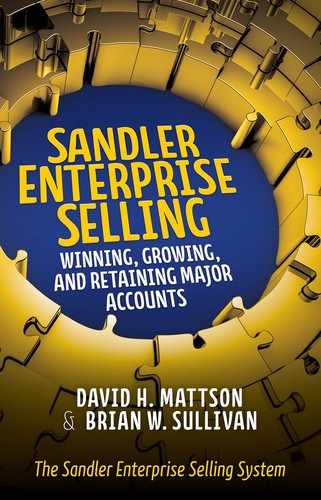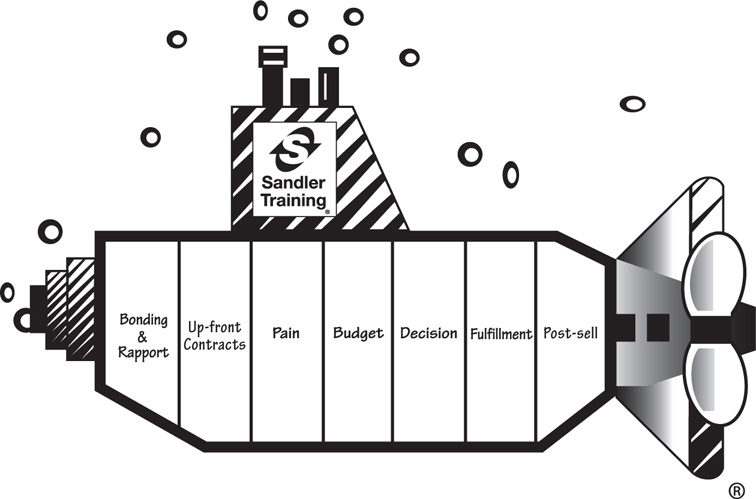READ THIS FIRST
Frequently Asked Questions About Sandler Enterprise Selling
What Is Enterprise Selling?
When we use the phrase “enterprise selling” in this book, we mean selling into organizations that present any of the following challenges to the selling team: extended sales cycles; sophisticated competition; significant financial investment in pursuits; cross-functional teams; a focus on long-term business value rather than short-term pricing; wide, diverse buyer networks; complex decision structures; and a highly diversified organization and footprint.
Let’s look at each of these elements individually.
• Extended sales cycles. When you are selling to enterprise clients, sales cycles can take months—sometimes years.
• Sophisticated competition. Your competition for enterprise business is likely to be sophisticated, strategically focused, and relentless. They come prepared!
• Significant financial investment. Pursuing an enterprise client requires a significant financial commitment as well as human, managerial, and logistical resources—not to mention the opportunity cost of not pursuing other business.
• Cross-functional teams. Because buyer networks of enterprise clients encompass many functions, so should your sales team. Positioning corresponding representatives on your team will show the strength and substance that enterprise clients demand.
• Focus on long-term business value. With the enterprise client, the business value of the solution to develop and implement must be unassailable or winning the business will be impossible.
• Wide, diverse buyer networks. The buying centers of enterprise clients are composed of a wide variety of functions, including purchasing, accounting, marketing, and legal. This, without question, makes the sales process more complex.
• Complex decision structures. In traditional selling, decisions are typically made quickly and based on price versus performance. In the enterprise world, however, the decision process can be complex, multilayered and lengthy.
• Diversified organization and footprint. Enterprise clients differ from small business entities in their complex structures, multiple business lines, complexity of portfolios, depth, and breadth of markets served and globalization issues.
Enterprise selling is to traditional selling as chess is to checkers. Competitively pursuing large, complex accounts with multiple constituencies and multiple decision makers—to say nothing of winning and growing such accounts—is one of the biggest challenges for sales teams. Each of these pursuits represents a significant investment of the selling company’s human, financial, management, and logistical resources. In order to maximize those investments, multiple parts of the selling organization must work together seamlessly. The business value of the proposed solutions they identify, develop, and implement must be unassailable because the competition is likely to be well-prepared, sophisticated, and relentless.
What Is Sandler Enterprise Selling?
The Sandler Enterprise Selling (SES) program, based on the proprietary Sandler Selling System® methodology created by David H. Sandler, provides a practical six-stage approach for winning business with profitable enterprise clients, serving them effectively, and expanding the relationships over time.
SES is a comprehensive, reinforcement-driven live training program designed specifically for selling teams committed to high achievement in the enterprise environment. This book is a preview of the program, not a substitute for it. In this program, we’ve taken everything that’s made our training so effective over the past five decades and elevated it to address the unique needs of organizations selling to enterprise clients.
At Sandler Training, we’ve spent over 40 years helping companies around the world improve their sales processes to increase revenue and maximize profitability. What’s driven their success is our scientific, methodical, and proven approach to selling. Our approach in SES, as in all of our programs, doesn’t rely on quick fixes. Instead, it uses reinforcement to encourage incremental change over time to create lasting success.
Is SES Different from the Sandler Submarine?
No. It’s an extension of it.
In a traditional sale—a sale that closes in a relatively short period of time and has a straightforward decision-making process—the proven model for success has been, for decades, the Sandler Submarine.
This selling model begins with the establishment of Bonding & Rapport and the setting of an Up-front Contract between seller and buyer. It moves through clear mutual assessments of Pain, Budget, and the Decision process, which, ideally, ends with the Fulfillment and Post-sell steps, where the buying agreement is finalized.
All of this is relevant to, and part of, the enterprise sale. But many additional variables enter the picture in these more complex selling situations. In the enterprise selling model, there are important things that must happen before Bonding & Rapport and after Post-Sell. Not only that: everything between those two events carries with it both logistical and political complexity in the enterprise arena. SES addresses all these variables, without changing any of the core Sandler principles.
How Is SES Structured?
SES is based on six highly strategic stages offering a continuous process of attaining, serving, and growing an enterprise account.
1. Territory & Account Planning. In this critical stage, you set a strong baseline for success though comprehensive planning.
2. Opportunity Identification. Next you analyze, assess, and initiate interaction on your most promising opportunities with the highest probability of success.
3. Qualification. Here you execute a practical plan to engage with the enterprise buyers to clarify the key opportunity parameters, which will improve and reinforce your position.
4. Solution Development. Now you craft a compelling solution directly addressing the needs and pains of the enterprise and its most influential executives.
5. Proposing & Advancement. It’s time to finalize and deliver your client-focused solution and act on the resulting decision to achieve advancement.
6. Service Delivery. With the business relationship active, service delivery becomes critical: you coordinate team activities to maximize client satisfaction and grow the account.
The six interior puzzle pieces below represent the six interlocking stages of the SES process. Each of the stages is the focus of a main section of this book. Mastery of all six stages, via the live SES program and training that this book previews, is essential to competing and winning in this demanding selling arena.

While SES is explained with six sequential steps, in practice it’s a continuous cycle of ongoing selling to enterprise clients, serving them well and growing the business through streams of transactions over time.
What’s in That Outer Ring?
SES offers 13 powerful tools integral to the strategic SES stages, designed to deliver a serious competitive edge.
1. KARE Account Planning Tool: Empowers your sales process by delivering value in territory and account planning as a customized profiling tool for both current clients and prospects; also creates a common organizational lexicon and facilitates comprehensive account understanding.
2. Growth Account Booster Tool: Drives collaborative development of a targeted growth plan involving the sales, operational, and delivery teams.
3. LinkedIn® Levers Tool: Takes research up a notch by allowing you to easily access critical information on individual client contacts and accounts as a whole using LinkedIn, the gold standard for research on people and businesses.
4. Relationship Builder Tool: Provides a simple baseline to chart an account’s key decision makers and their personal goals; also identifies next steps to help enhance your relationship with each.
5. Three Opportunity Planner Tool: Ensures that focus is given to the highest probability short-term deals that position your organization for future business growth and profitability.
6. Positioning Tool: Identifies key buyers, your product/service’s value propositions, and those of your primary competitors.
7. Pre-call Planner Tool: Helps you maximize the potential of an upcoming call with a simple set of steps guiding you through prebriefing and preparation of both questions and answers.
8. Call Debrief Tool: Helps you discover valuable lessons learned from a just-occurred sales call, including information learned, next steps planned, red flags identified, and more; also acts as a vehicle for sharing information across the selling team, especially important for members not on the call.
9. Opportunity Tool: Provides up-to-date snapshots of three critical aspects of an emerging deal—the competitors, the client’s key pains, and the relevant applications; also provides action-oriented next steps.
10. Pursuit Navigator Tool: Brings together functional entities from across the selling organization to help drive Go/No-Go decisions regarding pursuits.
11. Client-centric Satisfaction Tool: Provides keen insights through a customized client satisfaction process designed to increase the probability of successful delivery and account expansion.
12. Team Storm Tool: Brings all client-serving elements together to work a problem or opportunity via a rapid team brainstorming process.
13. Client2 Tool: Enables the sales and delivery teams to grow enterprise client marketplaces by following a logical framework of activities; also provides guidance in identifying opportunity areas.
In What Industries Have These Principles Delivered Results?
Over the years, Sandler clients in every major vertical have implemented—and benefited from—the principles covered in this book. The key to success is not only the content you will read here (although the content is vitally important). It’s the ongoing reinforcement from Sandler.
Is the SES Process Only Relevant to Selling Teams That Target Very Large Organizations?
Most of the SES Tools are relevant to all sales teams. As for the program as a whole, it applies best to firms selling to decision makers within larger entities.
Our Selling Situation Is Unique. How Do I Know SES Is Right for Us?
The collaborative nature of SES allows it to fit well into any organization that sells into the enterprise space. The wide portfolio of tools that drive the program allows clients to focus on the specific tools that best map to their unique business models; those tools are customizable to fit the unique needs of a client’s particular selling environment. If your team is responsible for enterprise selling, SES is right for you.
What’s My Next Step If I Want To Learn More About SES?
Visit www.sandler.com/enterpriseselling or contact your local Sandler office.

